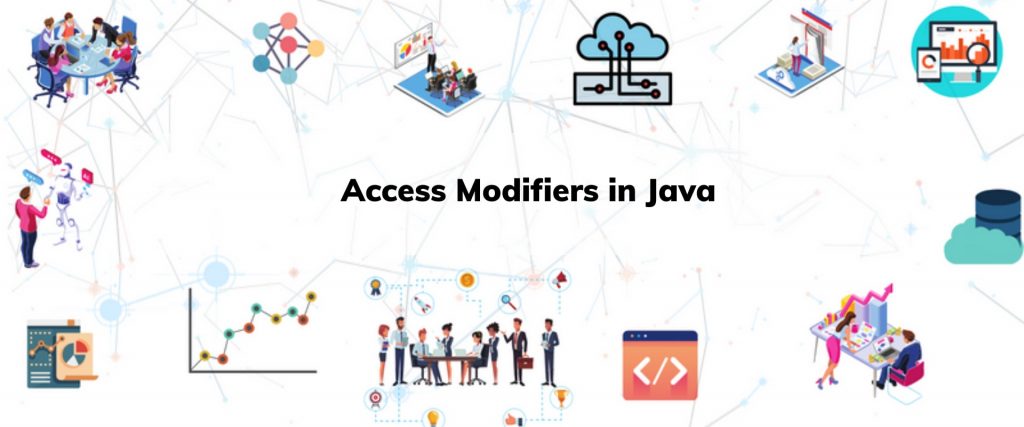The keywords which are mostly used in object-oriented languages that have the purpose to set accessibility of classes, methods, and other members are called the Access Modifiers.
In Java language they are in use to restricting or set the limits to the accessibility of classes, interfaces, variables, methods, constructors, data members, and the setter methods.
When we allocate an access modifier with class, constructor or method, it is also refer to, “marking” that as the access modifier specifies. For example, if we assign access modifier public to a method then, that would be called marking the method as public.
WHY ACCESS MODIFIERS?
- Access modifiers are really important features use in the Java language to make the code clean and efficient.
- They have a major role in dealing with the visibility of the class members.
- It has a greater dominance in deciding the control whether other classes can see or change methods or variables of the class.
- however, it has a greater role relating to implementation and defining the properties of the important part of Object-Orient Programming refer Encapsulation. It is a feature in which the linkage among data with the code takes place and it also can manipulate the data. With controlled access, we can prevent misuse.
Types of Access Modifiers
In the Java programming language, there are four types of access modifiers. The four types of access modifier are in the following ways:-
- Default Access Modifier
- Private Access Modifier
- Protected Access Modifier
- Public Access Modifier
Everything about the access modifiers in Java with full explanations and example code will be cover below which will justify the alarming necessity of the use of them in the Object-Oriented Programming language.
I. Default Access Modifier
- In the default access modifier, if no access is specifies for any class, method, or data member hence, then it is taken as default.
- The data members, class, or methods are accessible only within the same package that is not declare using any access modifiers.
- Classes from other packages cannot be used along with default modifiers. If we use then it will have a compile-time error. Let’s encounter it with an example below.
II. Private Access Modifier
The keyword private is use to specify the private access modifier. Data members and methods are only available in that class where it is declared. So, the members cannot be access by the equal package of which they were create, Among top-level classes or interfaces.
anyone out of them cannot be called private. Also, classes cannot be declare as private access modifiers. So, a Class with a private constructor also cannot create the object of that class from outside the class.
- Program to show error while using a class from a different package with a private modifier.
III. Protected Access Modifier
The keyword protected is used to specify the protected access modifier. The protected access modifier has an inclusive use where data members or methods declare as protect are accessible within the same subclasses or packages in non-identical packages.
- Let’s understand the use of a protected access modifier with the following sets of code.
- A second package where we import the first where the protected access modifier is in use.
IV. Public Access Modifier
- The keyword public is use to specify the public access modifier.
- It has the most spacious range in comparison to all other access modifiers.
- It helps any classes, methods, or data members to get access from anywhere in the program.
- So, it ensures there is no restriction on the scope of a public data member.
- Let’s understand the concept and usage of the public access modifier with the help of the code given below.
ACCESS MODIFIER AND INHERITANCE
- When the subclass of some class is create then the methods of the subclass are not less accessible than modifiers (assign) than when it’s in the superclass.
- It is not permissible to decrease the accessibility of an overridden method but, it is permissible to expand the accessibility of an overridden method.
- All these factors are responsible and have a greater role to define the usability and scope to bring the valuable concept of Inheritance in Java.
Image link: https://media.istockphoto.com/photos/generic-java-code-picture-id183805843
CONCLUSION
Hence, the access modifiers are keywords that have a greater role in defining the real functioning in Object-Oriented Programming and which helps us to get easy access to classes and members along with it helps to modify their behavior and scope. They provide rudimentary properties for the classes and their members. When thoroughly acquainted with them, the best use of them will flourish.
written by: Ashutosh Ray
Reviewed By: M SASANK SAI, Bujagawni Sai Teja Goud
If you are Interested In Machine Learning You Can Check Machine Learning Internship Program
Also Check Other Technical And Non Technical Internship Programs

